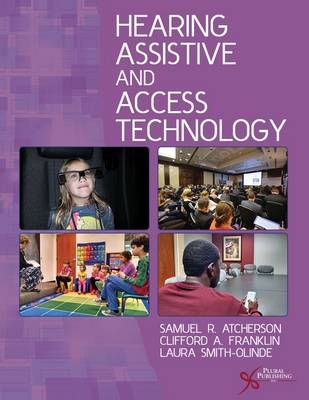
Hearing Assistive and Access Technology
Plural Publishing Inc (Verlag)
978-1-59756-512-7 (ISBN)
Samuel R. Atcherson, PhD, is an audiologist and associate professor as well as director of the Auditory Electrophysiology and Rehabilitation Laboratory in the Department of Audiology and Speech Pathology in a consortium between the University of Arkansas for Medical Sciences (UAMS) and the University of Arkansas at Little Rock (UALR). He has a secondary appointment as an adjunct clinical associate professor in the Department of Otolaryngology-Head and Neck Surgery at the University of Arkansas for Medical Sciences. Dr. Atcherson has presented more than 130 times on an array of topics related to hearing loss, technology, and health-related issues. He has more than 85 publications, including two books and six book chapters. His interests include auditory and vestibular electrophysiology, hearing assistive technology, and health literacy. Dr. Atcherson is familiar with and benefits from hearing assistive and access technologies - he is a bilateral cochlear implant user with previous hearing aid use for more than 30 years. Clifford A. Franklin, PhD, is an audiologist and associate professor in the Department of Audiology and Speech Pathology in a consortium between the University of Arkansas for Medical Sciences and the University of Arkansas at Little Rock. With more than 17 years of experience as an audiologist, his clinical experiences include working in university clinics as well as in a hospital setting. Dr. Franklin's clinical experience has contributed to his interest in hearing aid use. His research is mainly focused on the acceptance of background noise while listening to speech. Dr. Franklin's 42 national and international presentations and 17 publications cover a range of topics from acceptable noise levels to timely trends in hearing aids. Laura Smith-Olinde, PhD, is an audiologist and associate professor as well as director of the Educators Academy at the University of Arkansas for Medical Sciences. Before assuming her current position, Dr. Smith-Olinde was on faculty and taught in audiology and speech pathology programs for 16 years - most recently in the Department of Audiology and Speech Pathology in a consortium between the University of Arkansas for Medical Sciences and the University of Arkansas at Little Rock. She also served as the coordinator of the Infant Hearing Program for the Arkansas Department of Health for more than a year. Dr. Smith-Olinde has more than 30 publications with more than 80 presentations on varied topics related to hearing and hearing loss.
Part I. Fundamental Considerations Chapter 1. Introduction Chapter 2. Federal Access Laws for Deaf and Hard of Hearing Consumers Chapter 3. Acoustic Issues in a Variety of Listening Environments Chapter 4. Hearing Aids and Implantable Devices: The Starting Point for Hearing Assistive and Access Technologies Chapter 5. Needs Assessment Part II. Technologies for Hearing Enhancement Chapter 6. Frequency-Modulated (FM) Systems Chapter 7. Induction and Hearing Loop Systems Chapter 8. Infrared (IR) Systems Chapter 9. Contemporary Wireless Hearing Technologies Part III. Telecommunications and Related Technologies Chapter 10. Telecommunications Access Chapter 11. Text-Based Access Technologies Chapter 12. Alerting Devices and Services Part IV. Cases and Further Considerations Chapter 13. Case Studies Chapter 14. Health Professionals with Hearing Loss Chapter 15. What's New at the Zoo? Recent Advances in Technology
| Verlagsort | San Diego |
|---|---|
| Sprache | englisch |
| Maße | 178 x 254 mm |
| Themenwelt | Medizin / Pharmazie ► Gesundheitsfachberufe ► Logopädie |
| Medizin / Pharmazie ► Medizinische Fachgebiete ► HNO-Heilkunde | |
| ISBN-10 | 1-59756-512-1 / 1597565121 |
| ISBN-13 | 978-1-59756-512-7 / 9781597565127 |
| Zustand | Neuware |
| Haben Sie eine Frage zum Produkt? |
aus dem Bereich


